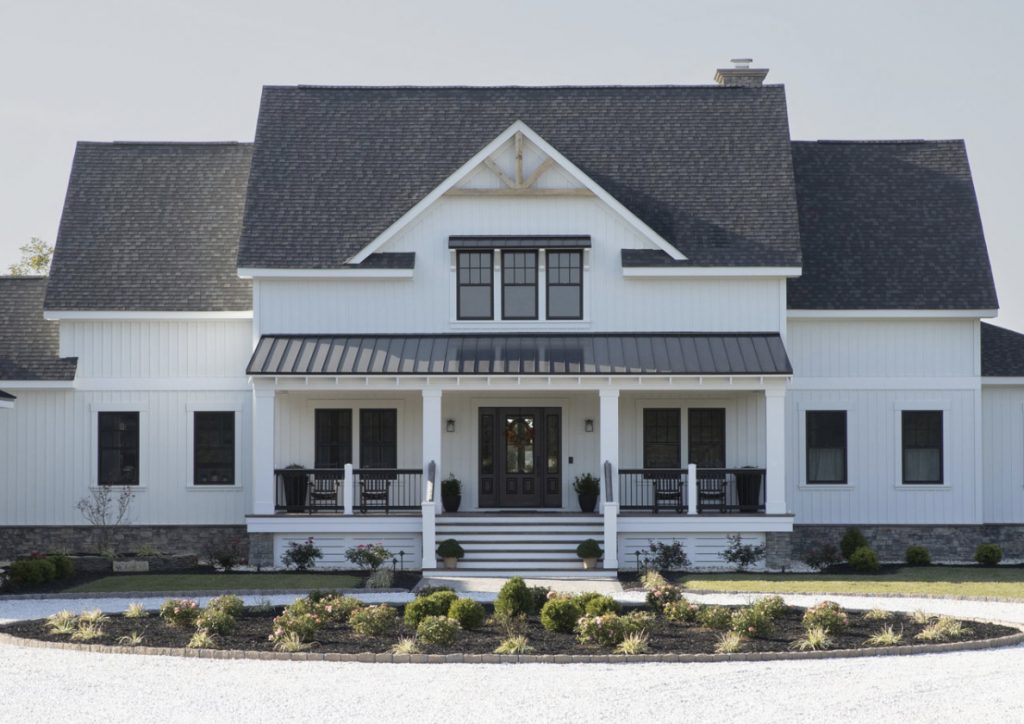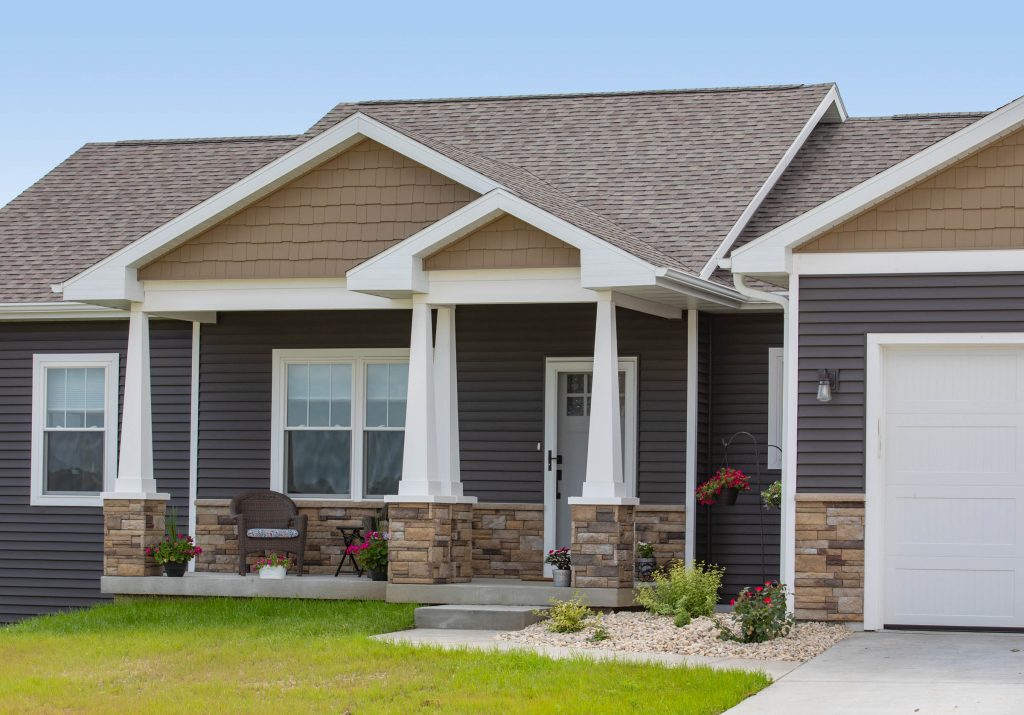Toward the end of each year, paint manufacturers and other experts announce their Colors of the Year. These highly anticipated declarations offer a reflection of life and society in the moment—our collective mood, influences, and emotional drivers—and guidance for the months ahead.
Some of this year’s prominent 2024 Colors of the Year selections divide neatly into two distinct categories: softer, more relaxed tones answering our mutual desire for peace and calm in a messy world, or bolder, dramatic hues delivering much-needed energy. Though the two sides are notably different, common themes include interpretations of “warmth,” “peace,” and “well-being.” All of the options, light or dark, evoke a depth and saturated richness that draw you in and strengthen each color’s versatility throughout the interior and exterior.
Described as a “breezy, blissful blue,” Sherwin-Williams’ Upward (SW 6239) is “a sunny-day shade for spaces brimming with positive energy, creative thinking, and total contentment.” Like the company’s 2023 color, Redend Point, the shade is soft but rich, soothing yet eye-catching, a way to make a statement without feeling overwhelmed. Pair it with greige neutrals, black, olive or honeydew green, or a desert brown.

Similar to Sherwin-Williams, Valspar’s Color of the Year, Renew Blue, is a soft-yet-rich hue in the blue family, but with green influences that lend a peaceful vintage feel evoking a sense of calm. “Most of us are seeking an end to feeling overwhelmed—less stress, less information, less technology, fewer choices. Simplicity,” the company said. “Here, we can slow down and create the peaceful place we seek.”
Pair it with mid-toned neutrals in tan and greige.

Pantone’s Peach Fuzz is “a velvety gentle peach whose all-embracing spirit enriches mind, body, and soul,” the global color authority says, noting that our need for nurturing, empathy, and compassion was a driver for this year’s selection. A “warm, cozy shade” between pink and orange, Pantone says Peach Fuzz offers a fresh approach to softness, with gentle lightness and a vintage vibe for a subtle sensuality that evokes new modernity.
“Pantone 13-1023 Peach Fuzz brings belonging, inspires recalibration, and an opportunity for nurturing, conjuring up an air of calm, offering us a space to be, feel, and heal and to flourish from whether spending time with others or taking the time to enjoy a moment by ourselves,” said Leatrice Eiseman, executive director for the Pantone Color Institute. “Drawing comfort from Pantone 13-1023 Peach Fuzz, we can find peace from within, impacting our wellbeing. An idea as much as a feeling, Pantone 13-1023 Peach Fuzz awakens our senses to the comforting presence of tactility and cocooned warmth.”

Limitless, a creamy, soft yellow from PPG, “instills a warm, sunny vibe that hints at growth and blooming energy,” the manufacturer said. By offering both “the power of a primary color and the essence of a neutral,” Limitless is, as its name suggests, a versatile option for interior and exterior applications as a full-body color or as an accent. The hue’s soothing vibe is in sharp contrast to vivid Vining Ivy, a Caribbean aqua, the company’s previous-year selection.

Confident and dramatic, Cracked Pepper from Behr is a versatile soft black that can make a statement as the primary focal point in the room or as a simple, classic accent. Lush and elegantly moody, Cracked Pepper provides a perfect contrast against creamy whites but is rich enough to stand alone without overpowering the space.

Another color selection that is dark but lush is Ironside, a deep olive that Dutch Boy describes as a “richly dimensional hue that soothes and reassures.”
“Creating a space for wellness should be a driving factor in everyday life,” said Ashley Banbury, color marketing manager for Dutch Boy. “That’s why taking a natural approach to healthy living and safe spaces is a pivotal part of the current landscape. Dutch Boy Paints’ 2024 One-Coat Color of the Year—the stunning, strong Ironside—incorporates all the above in one bold color and can be applied in one single coat.”
The company says the color provides a sense of sophisticated comfort behind furniture, art, and accessories.

The blue-violet of Benjamin Moore’s Blue Nova offers “depth and intrigue, balanced by an undercurrent of reassurance,” the paint manufacturer says. “This alluring mid-tone features an enchanting duality, capturing the spotlight with endlessly classic appeal.”
The company’s larger trending 2024 color palette features softly saturated hues for a nuanced contrast. “On adventures near or far, we encourage collecting poignant color moments with verve and personality that are unexpected and boundlessly magical.”
From Colors of the Year to exterior trends, get the latest insights by subscribing to our monthly enewsletter.
5 Home Exterior Trends for 2024A home’s exterior is often the first thing guests or potential buyers see, meaning its curb appeal can have a significant impact on making a good first impression. Whether refreshing or renovating a home, staying current on 2024 exterior trends can help make a statement, increase a home’s value, and enhance the comfort of the living space.
Here are a few home exterior trends we’re expecting in the new year.
Connecting people more closely with nature and natural elements, biophilic design can lead to increased well-being and productivity. Growing wellness and environmental concerns are driving demand for outdoor living space improvements and integration of nature in design, including elements like green roofs, living walls, and large windows.
You can create dramatic outdoor spaces by contrasting light and dark colors. For example, matte black can be paired with materials like brick, stone, shingles, and wood for an eye-catching twist. Bold, earthy tones such as navy blue, forest green, dark brown, and red can also be combined with nature-inspired materials for organic texture and warmth. Other trending colors for 2024 include vivid teal and aqua blue, which can induce a sense of serenity.
As climate change continues to intensify and lead to severe weather, there is a growing need for high-performance, weather-resistant building products. Homeowners continue to favor resilient materials that require less maintenance or replacement.
For example, Celect Cellular Composite Siding replicates the beauty and aesthetics of wood while remaining low maintenance and durable for a lifetime. Featuring a patented interlocking seam design, it keeps moisture out and almost completely eliminates seams. Plus, its Kynar Aquatec coating provides superior protection against ultraviolet rays, reduces energy demands and resists dirt, seasonal staining and insects.

Focused on creating seamless connections between interior and exterior spaces, 2024 exterior trends include an evolution in outdoor design that includes integration of outdoor kitchens and living areas. Elements such as fire pits, pizza ovens, outdoor entertainment, and games can be incorporated to personalize the space and provide a unique entertaining hub. Using cohesive materials and textures that can withstand the elements and flow from indoors to outdoors, such as stone veneer, can help elevate the space and further tie it to the home’s interior.
Blending various textures, finishes, and materials on a home’s facade can create a unique, visually dynamic look. Using a combination of materials like brick and vinyl siding or stone and wood can add depth and visual interest. An option like Versetta Stone delivers the authentic look and feel of stone in a panelized format that is easy to install with screws or nails and requires no metal lath or scratch coat. The stone siding features a tongue-and-groove system for perfect spacing, has a built-in rainscreen, and can be installed almost anywhere without additional footings for support.

A versatile design approach allows a home to transcend trends, ensuring its relevance and appeal over an extended period of time. In 2024, look for a rise in classic design trends featuring elements such as vertical siding, crisp white trim, and other modernized traditional styles as well as a shift away from minimalism that incorporates more nostalgic, personal touches to home exteriors, ushering in more of a transitional style.
To stay up to date on the latest trends, subscribe to our monthly enewsletter.
SEO for Building Pros: A Practical Guide to Boosting Online VisibilityIn the digital age, the first page of search results is the new storefront on Main Street. It’s where credibility is established and first impressions are formed. Search engine optimization (SEO), therefore, acts as the architect of this storefront, ensuring that your business is not just a hidden gem but a beacon that stands out in the crowded marketplace. SEO for building pros is your company’s ticket to the top of search results, where potential customers are searching for your services, and the good news is, you don’t need a marketing or IT department to get started.
Capitalizing on all that SEO has to offer involves tweaking your online presence to make your website more appealing to search engines. Why does it matter? Because when someone needs a contractor, they’re likely to trust the ones they find on the first page of Google.
Let’s break down the essentials of SEO for contractors with a focus on simplicity and practicality.

Now that we’ve established the significance of SEO for building pros in the digital landscape, let’s dive into actionable steps — changes you can implement immediately to enhance your online presence. Consider these practical tweaks and optimizations that can make a tangible impact on how your contracting business appears in search results.
Identify the words your clients are likely to use when looking for a contractor. For example, “siding replacement contractor.” Sprinkle these words naturally throughout your website.
Compress your images before uploading them to your website. This helps your site load faster, and Google appreciates that.
Double-check your business information on Google My Business. Is everything accurate? Great, you’re on the right track.
Updating your website pages regularly with relevant content signals to Google that you’re active and engaged. This is where a blog might come in handy. And you can start off small, maybe once or twice a month, turn the frequently asked questions and concerns of your customers into a thought leadership piece on your blog and share it through email, newsletters, and/or social media to drive viewers to your site.
SEO success is all about playing the long game. Unfortunately, none of these updates will change your search engine ranking overnight. If it did, everyone would be doing it! So stick with it, and keep monitoring the changes you’ve made and their impact. At the same time,look into alternative pathways that can propel your contracting business even more in the vast realm of Google visibility, such as:
Google’s Local Service Ads are like the fast pass to the top of the search results. Look into them — they’re worth it. These ads prioritize local services, ensuring that your business is prominently featured when potential clients in your area are actively seeking the services you offer.
If you have a bit of budget, PPC ads can give you a boost. With PPC, you set a budget for your ads, and you only incur costs when users actively engage by clicking on your advertisement. It’s a cost-effective way to ensure you’re reaching a targeted audience, maximizing your budget by paying for actual interactions rather than just impressions.
Consider PPC as a strategic tool to amplify your business presence, especially when aiming for specific demographics or promoting time-sensitive offers.
Remember, Rome wasn’t built in a day, and neither is a stellar online presence. Results take time. Be patient as you build your digital strategy and ramp up your SEO efforts.
This guest post was provided by Socius. Learn more about their SEO services below.
If you’d rather not take on an SEO strategy alone, Socius can work as an extension of your business to expand your digital marketing efforts and help you reach ready-to-act, qualified customers.
And now, Socius has partnered with EverConnect to offer you up to $2,500 in credit toward qualified new leads for your home improvement business when you partner with Socius for digital marketing. It’s designed to generate leads and business while your long-term SEO strategy takes shape. Learn more here.
Boosting your online visibility doesn’t have to be overwhelming. With the practical steps we’ve outlined in this blog, you’re well on your way to dominating the digital arena, one search result at a time.
4 More Ways AI Can Help the Construction Industry
By now you’ve likely heard about artificial intelligence (AI)—and if you’ve ever “conversed” with a company’s website chatbot, you’ve used it too. AI is the buzzword of the moment, for sure. As we’ve mentioned in a previous blog post, it’s not likely going to replace construction workers. But artificial intelligence is definitely showing potential to enhance what we do and create efficiencies in how we do it.
Previous AI opportunities we explored include pre-design support, design development, permit documentation automation, site safety, and materials management.
AI also has the potential to help your homeowner customers, as well, by streamlining processes and providing a better experience. Paul Burleson, Westlake Royal Building Products™ National Remodeling Accounts Manager, outlines some of the additional ways AI can be used in this industry:
1. Personalized recommendations: AI-powered tools can help homeowners get personalized recommendations on which products and materials to use, based on their preferences, budget, and specific needs.
2. Smart assistants: AI-powered smart assistants such as Amazon Alexa and Google Assistant can help homeowners with a range of tasks, from turning their lights on and off to adjusting the temperature in their home. Homeowners can use these assistants to control various smart home devices, which can help to improve their overall living experience.
3. Virtual home improvement tools: AI-powered virtual tools can help homeowners visualize changes before they make them. This technology can be used to create 3D models of a home’s interior and exterior, allowing homeowners to see how different paint colors, furniture, and décor will look in their home before making a final decision.
4. Predictive maintenance: AI can be used to predict when maintenance needs to be performed on home appliances, systems, and other components. This can help homeowners to avoid costly repairs and replacements, as well as ensure that their home is always functioning at its best.
Overall, AI has the potential to revolutionize the home improvement industry, making it easier and more convenient for homeowners to improve their living spaces. For more ideas, be sure to read our previous coverage here.
Image credit: iStock.com/metamorworks
Survey: What Are Homeowners Planning for Home Remodeling?
What are Westlake Royal Building Products’ homeowner customers and potential customers thinking about for their upcoming home remodeling projects? We recently surveyed 114 subscribers to the Live Abode consumer blog about their design plans and preferences. Here are a few insights:
When it comes to their “dream” architectural styles, Traditional continues to reign, with 34.3% of respondents selecting the style. Coastal (18.9%), Farmhouse (15.3%), and Mid-Century Modern (10.3%) styles followed.
Of homeowners who are planning to remodel, 22% said they plan to prioritize interior projects, while 14% are planning an exterior renovation.
Homeowners who are planning to upgrade their exterior space are targeting regular refreshes and updates over a full deck project.
But what if money were no obstacle? When asked what changes they would make to their homes if they had an unlimited budget, 21.6% would tackle an interior remodel and 17.7% would renovate the exterior. A deck or porch expansion was a close third, with 13.8% of respondents selecting the option.
While responding homeowners indicated they are planning interior remodels more than exterior, they’re seeking knowledge mostly on exterior projects, which could indicate that such projects are next up on their lists or are forming in their minds. We asked what they’d like to hear more about, and their most-wanted topics were exterior home ideas, siding and trim, and outdoor living spaces, followed by paint color trends.
For your homeowner customers working through the decision and design process, Westlake Royal Building Products™ offers a number of tools to assist both you and them. These include:
• Online design tools: The Virtual Remodeler, the Dream Designer, and HomePlay Prime each allow buyers to mix and match products on an image of their own home or a similar home.
• Live Abode: Our design blog written especially for homeowners is delivered directly to their inbox. Access and subscribe here.
• Color Explorer: Choose color families and find products that match and coordinate. Click here to access.
• Color Combinations: Start with a base color and mix-and-match coordinating accent colors. Click to access Royal Color Combinations, Exterior Portfolio Color Combinations, and Celect Color Combinations
Browse all of our exterior and interior products, access samples and resources, and find inspiration at www.westlakeroyalbuildingproducts.com.
Dealers Ramp Up Adoption of Ecommerce, Other Technologies
The construction and LBM industries are notorious for their slow adoption of technology. This includes ecommerce, which has lagged behind the pace of other industries. But the pace of adoption is increasing, driven by several factors, most notably the pandemic, wider acceptance, and demand from the next generation of customers and workers. And, perhaps surprising to some, AI is also playing a role.
According to LBM Journal’s 2023 LBM 100 survey, 40% of dealers offered online sales in 2022, a 9.5% increase over the previous year. Of those, 27.4% of orders were for curbside pickup.
“We’re hearing from almost every dealer we talk to that there is a real awareness that ecommerce is a needed element,” said Mike Berger, managing editor for LBM Journal. “The buying habits not just of consumers but also pros have changed so much since the pandemic started.”
Consumers have gotten used to logging onto not only Amazon but also home improvement retailers like The Home Depot and Lowe’s to compare prices and make purchases; LBM dealers are realizing that they need to ramp up their own ecommerce to keep up.
“Ecommerce is here, it’s only going to increase, and dealers are going to need to make every effort they can to accommodate it,” Berger said. “Younger folks coming into the LBM industry are bringing with them patterns of commerce they’ve already developed. To them, it’s second nature to be able to go to their phone, go to an app, place their order, and be done.”
While ecommerce has lagged, LBM dealers have made strides in other areas of technology. In its 2023 Construction Supply 150 report, Webb Analytics noted that while construction suppliers continue to devote a low percentage of revenue to technology, they’ve made remarkable gains. “Online bill presentation now is common, with online payment capabilities close behind,” the report explained. “The next big trends will involve notification of delivery status and online information about whether a product is in inventory. Both are likely to be features of customer-facing apps for smartphones—another growing trend.”
Dealers have responded to customer demand for easier access to accounts and pricing by making it easier to pay bills or check inventory online, a must-have for building pros who do office work after regular business hours because they’re on the jobsite all day. Online access may also be beneficial for customers for whom English is not their first language.
“Despite spending an average of less than 1% of revenue on technology—far below most other industries—leading dealers have gotten dramatically more techie over the years, especially this decade,” the Construction Supply 150 said. “We’re at the point where more than two-thirds of responding CS150 dealers make it possible for their customers to see purchasing history and bills online, and another quarter of the dealers plan to add that capability. Over half permit online bill payment, and another 30% plan to roll out the feature.”
One reason ecommerce might be slower to adopt is because pricing and supply in the building sector isn’t always black and white. Supply chain challenges, particularly over the past few years, have made it harder to predict what is available, and pricing can be impacted by a number of factors that vary customer by customer.
But, ironically, technology is helping to address those challenges, as well. “The stock issue is gradually improving as dealers get better warehouse systems,” Webb Analytics President Craig Webb said. “The pricing is getting better in part because dealers are getting more sophisticated at being able to categorize customers.”
Webb’s Construction Supply 150 found that 35% of dealers have a warehouse management system, but another 26% want to add it. Delivery notification systems are also on the rise, the study found, with 40% of dealers offering it now; 79% of dealers have dispatch/delivery software, which means notification offerings could rise soon.
For now, Berger said, many customers are using ecommerce for smaller items or one-off items, such as a few extra 2x4s or other missing materials needed to quickly complete a job. Consumers are using it as part of their pricing research, which positions dealers to potentially earn new business if they have an item at an equal or better price as a nearby big box store.
Webb and Berger both point to artificial intelligence (AI) as an important factor for dealers going forward.
“It looks like artificial intelligence’s ability to slice and price could be one of the very first ways AI makes an impact on dealers,” Webb said. “It’s possible to collect tons of information about customer history and purchasing patterns, to scrape the internet for what everyone else is selling for, and to look at commentaries on what’s happening with pricing trends, strikes, forest fires, etc., and make pricing recommendations in the moment for customers. [As a simple example,] it’s an automated way of seeing a winter storm coming and analyzing how many shovels you have.”
Berger said one of the biggest fears he hears from dealers is that adding ecommerce means increasing the amount of staff needed to handle it. But dealers who have found success are reporting the opposite, thanks in part to AI tools that can assist with filling out product descriptions, answering common questions, and more. “With the tools that are available, dealers aren’t having to radically ramp up their hiring.”
Existing and trusted software solutions also are playing a key role in getting dealers up to speed. The industry’s leading software providers offer systems that allow companies to run programs for what they want and need while adding or removing capabilities in the future.
Epicor’s enterprise resource planning (ERP) solution, for example, has an option for an integrated ecommerce platform.
ECI announced in July a new ecommerce solution for its Spruce ERP platform. The tools allow dealers to build a professional storefront website and customer portal without the need for coding or web development expertise. “For consumers and tradespeople, this means unlocking the ability to shop online for delivery or in-store pickup, browse products, create accounts, build self-service quotes, pay invoices, and more,” John Maiuri, division president LBMH at ECI, said in an announcement of the launch. “For LBM and hardlines businesses, this means help in avoiding over-stocking since inventory counts, transactions, pricing, invoices, and other information are directly connected between systems.”
It’s clear that more and more LBM dealers are embracing the efficiencies that technology can bring—while recognizing that customers will only continue to expect such conveniences in the future. As technology solutions become more advanced and more user-friendly, there perhaps may be no better time to take the leap.
Gain more insights and stay connected with Westlake Royal Building Products® on LinkedIn.
Related content:
Image: iStock.com/gorodenkoff
3 Ways Leadership Is Evolving to Ensure Happier Employees and Customers
Anyone who has ever had a bad boss knows there’s at least some truth to the oft-quoted phrase “Employees don’t leave companies, they leave bad bosses.” Along with employee turnover, poor leadership on the part of managers and supervisors can impact employee morale and overall operations to a point of causing inefficiencies, costly mistakes, and, ultimately, unhappy customers.
According to Paul Burleson, Senior Account Executive of National Remodeling Accounts for Westlake Royal Building Products™, we need to see a paradigm shift in our approach to leadership—a significant change in the way leadership is viewed, practiced, and executed.
“Historically, leadership was often associated with a top-down approach where leaders made decisions and gave instructions to their subordinates,” Burleson says. “However, recently, there has been a significant swing toward a more collaborative, inclusive, and participatory style of leadership.”
Burleson describes three ways the old methods are changing:
Overall, these paradigm shifts are a response to the changing nature of work and the evolving needs and expectations of today’s workforce, Burleson says. By adopting more inclusive, emotionally intelligent, and collaborative leadership styles, leaders can create a more engaged and empowered team that is better equipped to navigate the complexities of the modern workplace.
Stay connected with Westlake Royal Building Products on LinkedIn.
How to Leverage AI in the Construction Industry
In a rapidly evolving world where technological advancements are reshaping industries, artificial intelligence (AI) has emerged as a game-changer. People are already using it to create more efficient schedules, develop recipes for their leftovers, and even create code to build websites when they have no web development experience.
But what about industries that are hands-on like construction? AI can’t build a home, right? It can’t put on a roof or replace old plumbing pipes, can it?
No, but it can help make many of the processes faster and safer.
Before delving into the details of AI in construction, it’s crucial to address a common concern: the fear of AI replacing human workers.
Rest assured, AI is not here to replace construction jobs; rather, it is here to enhance existing roles. AI technology can be a powerful tool to aid construction workers, boost their productivity, and streamline processes, leading to more efficient project execution.
The future of the construction industry lies in embracing advancing technologies to unlock its full potential. By integrating AI and construction, we may see remarkable improvements in each stage of the building process, especially during planning. It can streamline processes, reduce costs, minimize errors, and optimize overall efficiency in construction projects.
Here are some of the ways AI might be used (or is already being used) in the construction industry:
AI and pre-construction
Performance and safety during the construction process
If we want to fully harness the power of AI in the construction industry, it’s imperative to continue collaboration between technology providers and construction professionals.
The potential benefits are emerging: streamlined processes, lower costs, improved accuracy, enhanced safety, and optimized project management, just to name a few. But the journey doesn’t stop here — continued research, development, and adoption of AI technology may be crucial to move the industry forward.
One way Westlake Royal Build Products is embracing technology is through our available Home Design Tools. Create your own home masterpiece by interacting with our design tools.
Better Sales Starts With the Introduction
Technology is great. But in the midst of it taking over our lives and jobs, something has gone missing from the sales process—the power of human touch. “We’ve lost the art of connection,” says sales expert Charlie Cina. “Everyone wants to be high tech, no one wants to be high touch.”
Specializing in sales and online training, Cina is a consultant, writer, and speaker with clients around the world. He has developed a unique prospecting tool called OneTapConnect, which allows you to have immediate impact and influence by sharing your custom-branded mobile site that shares your social profiles, website, and other custom links.
Cina isn’t saying technology doesn’t have a place in sales, but the ability to build instant rapport and credibility with a potential customer that also allows you to create trust by showing your truth, authenticity and proof is paramount in any sales process.
“I believe you have to be both high tech and high touch,” Cina says.
Cina notes that there are organic opportunities around us each and every day, and he suggests introducing yourself to five new people on a daily basis—at your child’s baseball game, in line at the dry cleaner’s, etc. “Your job as a sales professional or business owner is to introduce yourself to as many people as you can and shout from the rooftops who you are, what you do, and how you can help.”
Is every person you meet in need of your subcontracting skills or the products you sell? Not likely. But everyone knows someone who knows someone, and by introducing yourself and making an impression, you become memorable when such a need arises among the people they know.
“The whole concept is the people out in the world have two things you need: They have your money or they have your potential contact/connection with people who do want your products and services.”
Making an introduction can be an intimidating experience, but it’s pretty simple.
First, it helps to reframe your thinking: It’s not a “cold call,” it’s a “new call.” Follow the simple formula: Introduction, build rapport, gain credibility.
Learn how to say hello, your name, who you are, and what you do. Present yourself in a way that’s unforgettable at the first point of contact. “Stick your hand out and introduce yourself. ‘Hi, my name’s Charlie, what’s your name?’” Cina says. “As soon as they tell you their name, you’re no longer strangers.”
Just be sure to come from a place of good intention, Cina explains. “You’re out there to have a conversation. Everyone is not a prospect for what you do. But master the art of human interaction and connection, and you can sort a prospect from a suspect. It’s not always a financial transaction; it might be a friendship or a referral. The whole key is when you’re out in the world, it’s your intention to get attention. You are a brand called you.”
The more you do it, the easier it becomes, Cina promises. Rather than practicing on family and friends, who can be your harshest critics, he recommends that you practice by doing.
Much like dating, if you’re not out there, you won’t meet someone. “Activity breeds activity,” he encourages. “The more you introduce, the more you produce.”
Want to learn more skills from Charlie Cina? Check out his book Expose and Close and his website https://charliecina.com, which includes a blog and online academy. Learn more about his OneTapConnect prospecting system here.
How to Be a Master at Canvassing
Canvassing is an essential strategy for introducing potential customers to new products, services, and ideas. As a canvasser, you get to interact with people face to face, listen to their feedback, and help them find solutions that fit their unique needs. Being a master at canvassing requires you to have the right skills and mindset to connect with people on a personal level and close deals effectively.
Here are some tips from Paul Burleson, Senior Account Executive of National Remodeling Accounts for Westlake Royal Building Products™, to help you become a master canvasser:
1. Be confident: Confidence is key when it comes to canvassing. You need to believe in the product or service you are offering and be sure of the value that it adds to the potential customer’s life. Confidently express the benefits of your product or service, and be ready to answer any questions regarding it.
2. Know your product: To be an effective canvasser, you need to have a deep understanding of your product or service. Know its features, benefits, and limitations. Highlight the essential points and how they benefit the customer.
3. Listen actively: Listening actively is an essential skill for any salesperson. Listen carefully to your potential customer’s needs and pain points. Once you identify those, show them how your product or service will address them. People appreciate it when someone listens and offers a solution that meets their needs.
4. Use persuasive language: Master canvassers know how to use persuasive language that creates an emotional connection with customers. Use descriptive language and meaningful expressions that make your value proposition compelling. Use persuasive techniques like storytelling and use of emotions relevant to the product/service you’re selling.
5. Be personable: One of the most crucial aspects of canvassing connecting with the customer on a personal level and making them feel comfortable talking to you. Use open-ended questions to keep the conversation flowing and get to know them. Show that your concern is not only to sell but also to help them solve real problems for them.
6. Build rapport: Building rapport is crucial, especially when canvassing door-to-door. Strike a conversation with customers about their hobbies, interests, or environment. This will help to build rapport and make the customer feel more comfortable talking to you. Smiling, making eye contact, and using the customers’ names are excellent tools to create strong rapport.
7. Follow up: Follow-ups are critical to closing the deal. Whether the response you get from the customer is positive or not, be sure to thank them for their time and give them a business card or brochure. If you follow through on your commitments and regularly touch base to maintain the connection, your efforts will yield returns in the long run.
In summary, becoming a master canvasser takes practice, patience, and commitment. Confidence, product knowledge, and preparation are key.
Stay connected with Westlake Royal Building Products on LinkedIn.
Related content:
• Resources for Selling and Installing Siding & Trim
• Stop Selling. Start Solving Homeowners’ Pain Points.
Featured image: iStock.com/grandriver